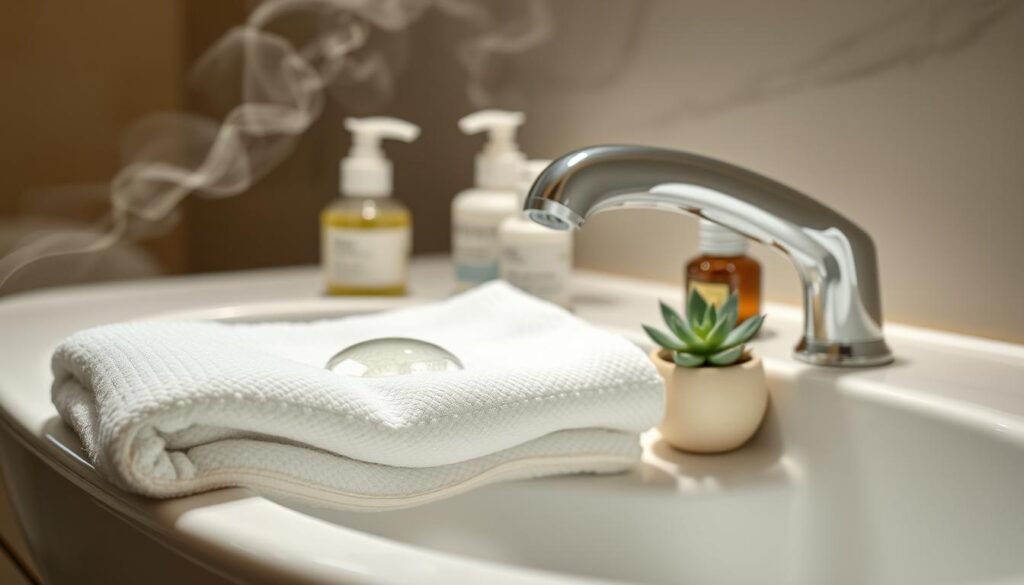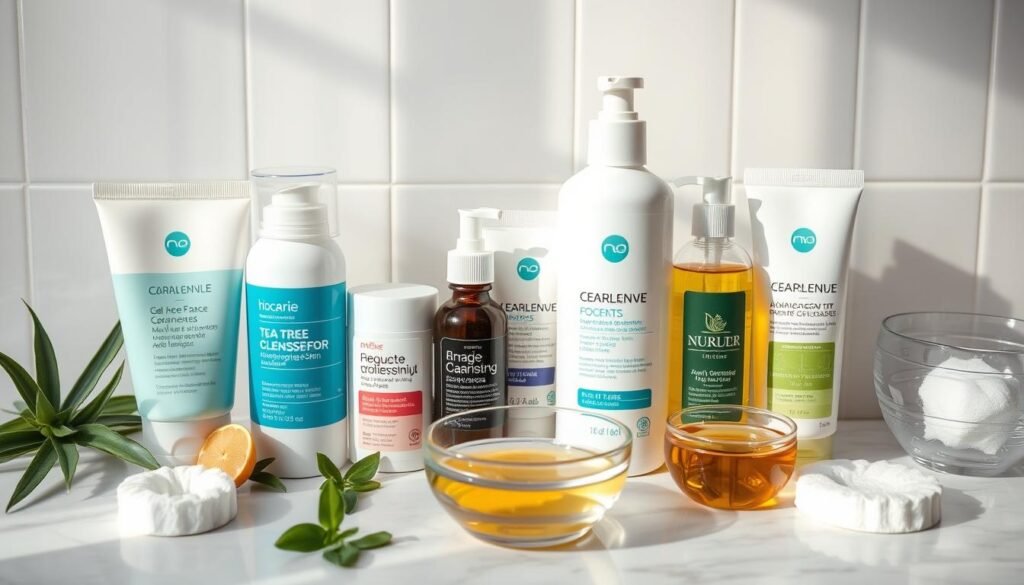Did you know around 85% of adults deal with acne at some point? This fact shows how crucial proper face washing is for those with acne-prone skin. It’s not just about clearing up breakouts. Proper cleansing keeps your skin healthy. By following a good Acne Skincare Routine, you can help prevent pimples and get clearer skin.
This guide is packed with helpful advice for effective face washing. It’s designed to help you fight acne well. You’ll learn how to pick the right products and understand how cleansing works. This article is your map for better skincare habits.
Key Takeaways
- 85% of adults face acne challenges at some point.
- Effective cleansing reduces acne flare-ups.
- An Acne Skincare Routine is key for healthy skin.
- Choosing appropriate products can prevent breakouts.
- Understanding skin types aids in selecting cleansers.
- Consistent cleansing habits lead to better skin health.
Understanding Acne-Prone Skin
Understanding Acne needs us to look closely at what causes it. Many deal with acne because of different reasons. These range from hormonal changes to excess oil and bacteria. Knowing the Causes of Acne helps in making a good skincare routine.
What Causes Acne?
Acne starts with many factors working together. Hormones change during puberty, menstruation, and pregnancy, causing more oil production. This oil and dead skin clog pores, creating a place for bacteria to grow and cause acne. Also, what we eat and stress can make acne worse. Knowing these facts helps in managing our skin better.
Identifying Your Skin Type
Finding out your skin type is key in Skin Type Analysis. Skin types include:
- Oily
- Dry
- Combination
- Sensitive
Every skin type responds differently to products and the environment. For those with acne, knowing their skin type is very important. For instance, oily skin might like oil-free products. Dry skin may need more moisture. Knowing this helps choose the right cleaning methods and products. You can find more cleaning tips in this article.
In short, understanding the Causes of Acne and your skin type lets you better handle your skincare. It leads to healthier, clearer skin by making informed choices in cleaning and product use.
The Importance of Cleansing in Acne Management
Cleansing is key for those with acne. It removes dirt, oil, and makeup that build up daily. These impurities can block pores and cause acne. So, keeping a good cleansing routine is crucial. Studies show that regular cleaning leads to clearer skin over time.
How Cleansing Affects Acne
Cleansing does more than just remove dirt. It keeps your skin healthy. Cleansing gently is important to avoid irritating acne-prone skin. Using harsh cleansers can remove natural oils. This makes the skin produce more oil, worsening acne. Knowing how cleaning affects acne is vital for managing it.
Building a Daily Skincare Routine
A good daily skincare routine is essential for controlling acne. It should have steps for both morning and night. Washing your face in the morning wakes up the skin. Night routines clear the day’s impurities. Slowly adding products suitable for your skin is key. For more on cleansing, check the American Academy of Dermatology.

Cleansing for Acne-Prone Skin: Best Practices
Maintaining clear skin means picking the right cleaning products. It also means setting up a skin care routine that suits you. This process includes knowing which cleanser works for your skin. And figuring out how often you should be cleansing.
Choosing the Right Cleanser
For those with acne, choosing the right cleanser is key. Look for non-comedogenic products. These won’t clog your pores. Gel cleansers with salicylic acid or benzoyl peroxide are good. They help unclog pores and lessen breakouts. Plus, they’re gentle on your skin. Stay away from harsh soaps. They can strip away natural oils and worsen irritation.
Frequency of Cleansing
How often you wash your face matters when dealing with acne. Cleaning your face twice a day is often recommended. Once in the morning and once at night. This helps remove oil and dirt without drying out your skin too much. Washing too much can actually irritate your skin and make acne worse. Finding that perfect balance is crucial for a healthy skin. For detailed advice on acne, look at current dermatological studies.
Types of Cleansers for Acne-Prone Skin
Knowing the different types of cleansers is crucial for those with acne-prone skin. Finding the right cleanser helps achieve clearer skin and prevents pimples. You can pick from oil-free options and decide if a gel or cream cleanser suits you best.
Oil-Free Cleansers
Oil-free cleansers get rid of excess oil without making your skin greasy. They are great for oily skin types because they help avoid clogged pores. Many contain salicylic acid, which fights acne while cleaning the skin gently. Brands like Neutrogena have various oil-free products aimed at combating acne.
Gel vs. Cream Cleansers
Choosing between a gel cleanser and a cream cleanser depends on their different features and benefits.
- Gel Cleanser: Gel cleansers are usually lighter and offer a cool cleansing experience. They are good for oily or combination skin types. These cleansers often have ingredients that assist in controlling acne, leaving the skin feeling fresh.
- Cream Cleanser: Cream cleansers give a moisturizing cleanse and are ideal for dry or sensitive skin. They keep the skin hydrated while getting rid of dirt. Cream cleansers can calm irritated skin, making them suitable for dry skin with acne issues.

Deciding on a gel or cream cleanser comes down to personal skin needs and what feels right. Looking into the ingredients and how they meet your skin’s needs is key for healthier skin.
Gentle Exfoliation Techniques
Gentle exfoliation is key for people with acne-prone skin. It removes dead skin cells, making the skin’s texture better. This helps stop pores from getting clogged. Knowing why exfoliation is good will help you have clearer, healthier skin. It’s important to exfoliate carefully to avoid making acne worse.
The Benefits of Exfoliation
Exfoliating does more than just clean the skin’s surface. It does several helpful things:
- Remove dead skin cells that accumulate on the surface.
- Promote cell turnover, revealing fresher skin underneath.
- Unclog pores, reducing the likelihood of breakouts.
- Improve the overall texture and appearance of the skin.
Safe Exfoliation Methods
It’s important to know the difference between chemical and physical exfoliants for safe exfoliation. Chemical ones like AHAs and BHAs are softer. They don’t scratch the skin. Physical ones like scrubs or brushes might irritate and inflame acne-prone skin more. Below is a summary of both types:
| Exfoliation Method | Type | Effectiveness | Risk Level |
|---|---|---|---|
| Chemical Exfoliants (AHAs/BHAs) | Chemical | Effective for deep penetration | Low |
| Physical Exfoliants (Scrubs/Brushes) | Physical | Surface level exfoliation | Medium to High |
Selecting gentle exfoliation methods is safe and enhances the benefits for acne-prone skin. Adding these techniques to your skincare routine can really improve your skin’s health over time.
Balancing Skin’s pH Levels
Keeping your skin’s pH balance is crucial for its health and functionality. An appropriate pH level can help avoid problems. This includes too much oil, which may cause acne. Knowing about pH Balance Importance is vital for good skincare.
Why pH Balance Matters
The skin’s natural pH usually sits between 4.5 and 5.5. This acidic setting fights off harmful bacteria and keeps the skin’s barrier strong. If the skin’s pH levels are off, you might see dryness, irritation, or more oil. That’s why Balancing Skin’s pH is essential in any skincare routine.
Techniques to Maintain pH Balance
Here are some effective pH Maintenance Techniques to keep your skin in check:
- Use a pH-balanced cleanser suited for sensitive or acne-prone skin.
- Add a toner after cleansing to help restore pH levels.
- Stay away from strong soaps or cleansers that could remove natural oils and mess with pH balance.
- Choose moisturizers that are made to maintain the right pH.
Removing Excess Sebum Effectively
Understanding how sebum is made helps a lot in controlling acne-prone skin. Sebum is the natural oil our sebaceous glands produce. It keeps our skin moist and fights off bad bacteria. But, too much sebum can block pores and cause acne. This section will look at ways to reduce sebum and keep skin healthy.
Understanding Sebum Production
Sebum production is a body’s normal reaction to things like hormones, diet, and stress. Changes in hormones, like those during puberty or menstrual cycles, can make the body produce more oil. Knowing what triggers an increase can help in finding ways to control excess oil.
Strategies for Reducing Sebum
To help manage sebum, there are several steps you can take:
- Use oil-free cleansers: Choose products made to fight oily skin. Ingredients like salicylic acid help manage oil and avoid acne.
- Implement lifestyle modifications: Drinking plenty of water, reducing stress, and sleeping well can help with sebum control.
- Make dietary changes: Eating less refined sugars and more antioxidants can lower sebum levels.
- Incorporate topical treatments: Using benzoyl peroxide and retinoids can both control and treat breakouts.
Integrating Non-Comedogenic Products
For those with acne-prone skin, using non-comedogenic products is a must. These items don’t clog pores, helping prevent breakouts. Brands like Neutrogena and Clinique have many options that care for the skin without causing acne.
What Are Non-Comedogenic Products?
Non-comedogenic products are made to lower the chance of acne. They leave out heavy oils and ingredients that can block pores. By choosing these skincare and haircare products, people can improve their skin’s look and feel.
Choosing Non-Comedogenic Makeup
Selecting the right makeup is key for those with acne-prone skin. Opt for “oil-free” or “non-acnegenic” products. Brands like BareMinerals and Fenty Beauty provide non-comedogenic makeup that keeps the skin looking great. Remember, sunscreen should also be non-comedogenic to protect the skin without causing acne.